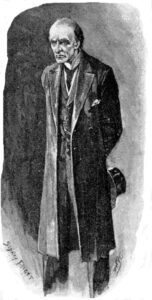This week on Most Heroic, we’ll be switching gears a little bit and instead of talking about heroes, we’ll be talking about their archenemies and why these comic book villains help define the honorable people who oppose them.
The archenemy is an important device in any form of storytelling. The term literally means the hero’s worst enemy, and they are ideally meant to represent everything that the hero fights against. Although the term is most commonly associated with the comic books, superheroes, fantasy, science fiction, and the struggle of good and evil in general, there have been examples of the archenemy being used outside of those typical genres. Here are some of the best examples of the archenemy in popular fiction.
Professor Moriarty
 Literary historians have pointed to Sir Arthur Conan Doyle’s Professor Moriarty character as one of the first examples of the super-villain, as well as serving as the one and only archenemy of the great detective Sherlock Holmes. Like Holmes, Moriarty is an extremely intelligent man, well-known for his mastery of mathematics and his book. However, unlike Holmes, Moriarty does not obsess over solving mysteries, but instead using his mind to obtain wealth. Though Moriarty has an unblemished public reputation, he is a man that seems to be devoid of morality, and he is known as “the Napoleon of Crime.” He is also the mastermind of a vast criminal organization based out of London. Once Holmes becomes aware of Moriarty and his organization, he immediately begins pursuing a way to bring the secret crime lord to justice, correctly believing it would be the crowing achievement of his career. However, Moriarty’s group is vast enough to make several attempts on Holmes’ life in one day, so skilled that they can’t be traced back to him.
Literary historians have pointed to Sir Arthur Conan Doyle’s Professor Moriarty character as one of the first examples of the super-villain, as well as serving as the one and only archenemy of the great detective Sherlock Holmes. Like Holmes, Moriarty is an extremely intelligent man, well-known for his mastery of mathematics and his book. However, unlike Holmes, Moriarty does not obsess over solving mysteries, but instead using his mind to obtain wealth. Though Moriarty has an unblemished public reputation, he is a man that seems to be devoid of morality, and he is known as “the Napoleon of Crime.” He is also the mastermind of a vast criminal organization based out of London. Once Holmes becomes aware of Moriarty and his organization, he immediately begins pursuing a way to bring the secret crime lord to justice, correctly believing it would be the crowing achievement of his career. However, Moriarty’s group is vast enough to make several attempts on Holmes’ life in one day, so skilled that they can’t be traced back to him.
Moriarty first appeared in Doyle’s The Final Problem, which was originally supposed to be the final Sherlock Holmes story. Though he had grown tired of writing the Holmes stories, Doyle still knew that if he was going to kill off the character, he had to let him go out in a blaze of glory. Thus, Moriarty was born.
As the decades have passed, the classic Sherlock Holmes stories have been remade time and time again, and Moriarty is often revived to combat the world’s most famous detective.
Doctor Doom
 Doctor Doom is one of the earliest characters co-created by Stan Lee & Jack Kirby for Marvel Comics, and he is considered by many to be Marvel’s greatest villain. Though Doom has fought almost every hero in the Marvel Universe at one time or another, he is and always will be the primary antagonist of the Fantastic Four. Doom hates every member of Marvel’s first family, but none more so than Reed Richards. Reed is one of the few men in the world who is smarter than Doom, and they both know it. Doom lives to defeat and humble his rival, and he’s come very close on several occasions.
Doctor Doom is one of the earliest characters co-created by Stan Lee & Jack Kirby for Marvel Comics, and he is considered by many to be Marvel’s greatest villain. Though Doom has fought almost every hero in the Marvel Universe at one time or another, he is and always will be the primary antagonist of the Fantastic Four. Doom hates every member of Marvel’s first family, but none more so than Reed Richards. Reed is one of the few men in the world who is smarter than Doom, and they both know it. Doom lives to defeat and humble his rival, and he’s come very close on several occasions.
Doom is brilliant, deadly, and most of all ruthless. He likes to operate as if he is a noble man, adhering to his strict code of honor at all times. If he gives you his word, he will keep it to the letter. The reality is that he would do anything to win. He has an immense lust for power and works as an opportunist at all times. Along with his immense scientific acumen, Doom is also an accomplished master of the mystic arts, sufficient enough to fight Doctor Strange. He always has a backup plan, and backup plans for his backup plans.
Interestingly, both Richards and Dr. Doom use their immense intelligence to help humanity. The only difference is that Doom insists on serving as humanity’s ruler. Doom’s massive ego will not allow anything else.
 In M. Night Shyamalan’s sophomore film Unbreakable, the Samuel L. Jackson character explains how the archenemy is usually given a color scheme to oppose the hero’s in order to accentuate the contrast between them. In the early comic books where men were drawn similarly, that was a useful tool so the reader could tell who was who, but it started to subtly evolve beyond that point. For example, Batman’s uniform is composed of dark and muted colors so he can better hide in the dark. The Joker, on the other hand, dresses in a flamboyant purple suit that would get anyone’s attention. This shows their different personalities and methods in a visual way.
In M. Night Shyamalan’s sophomore film Unbreakable, the Samuel L. Jackson character explains how the archenemy is usually given a color scheme to oppose the hero’s in order to accentuate the contrast between them. In the early comic books where men were drawn similarly, that was a useful tool so the reader could tell who was who, but it started to subtly evolve beyond that point. For example, Batman’s uniform is composed of dark and muted colors so he can better hide in the dark. The Joker, on the other hand, dresses in a flamboyant purple suit that would get anyone’s attention. This shows their different personalities and methods in a visual way.
The differences between the hero and the villain must extend further than merely color and costume, however. It must be a part of their psyches. Wolverine does his best to ignore his more violent impulses and he chooses to try and be the hero. On the other hand, his archenemy Sabretooth chose to abandon all elements of humanity and surrender totally to the beast within. He commits horrible acts of violence all in order to hurt Logan and his loved ones. That’s another thing that defines a good archenemy. The conflict is personal. When the Mad Hatter breaks out of Arkham Asylum, that’s certainly a problem. When the Joker comes back to Gotham, that’s when it gets real. You know that it’s going to get very ugly before it gets better, if it gets better at all.
I have always loved the archenemy stories, because they’re usually the best ones. They’re an entirely different class than the average foe. They force the hero to fight their greatest and most personal challenges, and the comic book villain is just damn fun overall.






